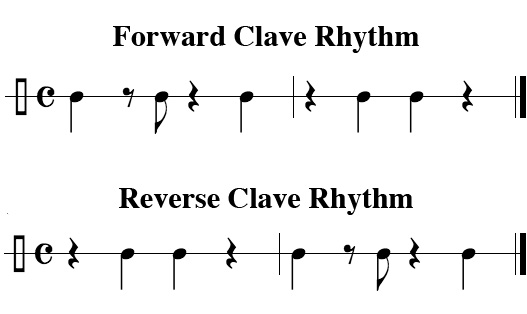Polyrhythm
Polyrhythms are multiple different rhythms being played simultaneously. They are used in many different cultures and different music all over the world. Sometimes they are created by music being played in multiple meters, other times it is multiple rhythms being played at the same time. For example triplets, 3 beats per count, being played with eighth notes, 2 beats per count. A polyrhythmic activity is trying to tap triplets with one hand and eighth notes with the other.
Polyrhythms in Piano and Classical Music
Polyrhythms in classical music is uncommon in terms of orchestras, symphonies, ensembles, solo instruments such as violin, cello, flute, the list can go on. An instrument that is common to have polyrhythm is the piano. Lovely composers such as Chopin and Skrjabin, Scriabin, are famous for their beautiful pieces that infuse a lot of polyrhythms. For example, Chopin’s Fantaisie Impromptu uses a four against three polyrhythms.
Listening to the video and looking at this section of the piece, we can see in the fifth measure the four against three. The first four measure sets up that triplet feeling and then you have the straight sixteenths at the fifth.
In this piece by Skrjabin, Scriabin, it uses a five against three polyrhythms. The Five against three rhythms really gives off this feeling of disorganization, but there is a flow to it. You can tell that the notes don’t equally match up, but it feels and sounds correct, which it is supposed to. What is uncommon is the group of five. In classical music, common groups of note consist of 2, 3, and 4. For some who are strictly classically trained, counting this group of five against three might be challenging. Ironically, Scriabin was influenced by Chopin, so it is evident where he gets his style from.
For those who believe that all classical music is straightforward, think again. There are many more classical composers who use polyrhythms in their works.
Polyrhythms in Modern Music
All being show in the above sections, polyrhythms are all too common. They are still prevalent in modern music. In fact they are use quite frequently, to a point where they are almost ignored by the typical listener. To the readers who are offended by the music of Taylor Swift, bear with me for awhile. Her song “22” is a perfect example of a rhythm that has a four distinct pulses with three pulses going as well. The two of them happen simultaneously causing the listener to be engulfed in pop music’s evermore difficult ability to bring new elements. The song itself happens to clearly show the polyrhythms best at about the 2:45 second mark in the link below. Sounding like a typical pop song, polyrhythms help make it more musical sound if it were to be analytical dismantled.
Taylor Swift - 22
Dream Theater on the other hand is a much different genre which clearly shows polyrhythms in action. Dream Theater is a progressive rock band first formed in the 1980s. The song itself starts out with several distinct rhythmic patterns which are far different from one another. Thus, it a prefect example of the wide use of polyrhythms to date in more modern music.
Polyrhythms in Latin Music
In Latin music the rhythm section primarily employs polyrhythms by combining many individual rhythms in groups of 2's and 3's.
The most popular example being the use of clave patterns in Salsa music. Claves are small wooden rods the are struck together to create a clicking noise and provide the base of Latin rhythms. The clave rhythm is a five note pattern that can be played either forward or backwards to create a rhythmic base fore all latin music.
It has no pitch range because the purpose of the instrument is rhythmic only, not intended for melodic uses. This pattern usually goes in the background while many other rhythms are being played by both melodic and rhythmic instruments such as drums, maracas and brass and strings.
Bibliography:
BeatScheme. ""POLYRHYTHMS"... an Introduction (for All Musicians)." YouTube. YouTube, 05 Feb. 2008. Web. 02 Oct. 2016. <https://www.youtube.com/watch?v=Zn7YtjO6Mqc>
"Claves." OnMusic Dictionary. N.p., n.d. Web. 02 Oct. 2016.
Claramxx. "Chopin, Fantaisie Impromptu." YouTube. YouTube, 26 Aug. 2007. Web. 01 Oct. 2016. <http://www.youtube.com/watch?v=fBA-38mzabs>.
Marioipu. "CLAVES AFROCUBANAS - Mario Ipuche." YouTube. YouTube, 08 Mar. 2014. Web. 02 Oct. 2016. <https://www.youtube.com/watch?v=DUIQlQdED7A>
"Mastering Odd, Complex Time Signatures And Rhythms." Mastering Odd, Complex Time Signatures And Rhythms. N.p., n.d. Web. 02 Oct. 2016.
MsBreault1. "Polyrhythm Definition and Example." YouTube. YouTube, 04 Nov. 2013. Web. 02 Oct. 2016.<https://www.youtube.com/watch?v=je1HTWiNEkY>
NewFFL3. "Scriabin 6 Preludes Op.13 - No.4 in E Minor." YouTube. YouTube, 14 Aug. 2014. Web. 01 Oct. 2016. <https://www.youtube.com/watch?v=2DYN--JIAz8>.
NeverEndingDaze. "Dream Theater - The Mirror/Lie." YouTube. YouTube, 23 Jan. 2011. Web. 02 Oct. 2016 <https://www.youtube.com/watch?v=AgFeZr5ptV8>
Ritmoschool. "3/2 Clave." YouTube. YouTube, 2009. Web. 02 Oct. 2016. <https://www.youtube.com/watch?v=UG9NacR29zM>
TaylorSwiftVEVO. "Taylor Swift - 22." YouTube. YouTube, 13 Mar. 2013. Web. 02 Oct. 2016.
Tjako. File:FI CHOPIN.jpg. Digital image. Wikipedia. Wikipedia, 20 Nov. 2014. Web. 01 Oct. 2016. <https://commons.wikimedia.org/wiki/File:FI_CHOPIN.jpg>.
Jonna
- Polyrhythms in Latin Music
- Finding medias
- Intro/Conclusion
- Editing and Revision
Chase
- Build Blog
- Polyrhythms in Modern Music
Kailee
- Polyrhythms in Piano/Classical
- Bibliography
- Post to Sakai

No comments:
Post a Comment